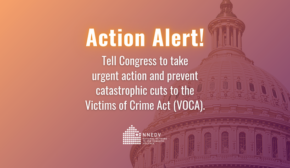Honoring the International Day of the World’s Indigenous Peoples: A Call to Action
August 9, 2016
August 9th marks the International Day of the World’s Indigenous Peoples, a day observed to promote and protect the rights of indigenous peoples around the world. On this day, the National Network to End Domestic Violence (NNEDV) urges Congress to ensure safety and justice for tribes and on tribal lands by adopting a resolution to create a National Day of Awareness for Missing and Murdered Native Women and Girls and by expanding tribal access to services and federal funding.
Violent crime victimization on tribal lands is significantly higher than in the rest of the United States, and research shows that Native women and girls face a disproportionate risk of violence when compared to their non-Native peers. In some tribal communities, American Indian women face murder rates that are more than ten times the national average. [1] A staggering 39 percent of Native women had experienced domestic violence – a higher rate than any other racial or ethnic group. [2] It was further found that Native women were 2.5 times more likely to be sexually assaulted than U.S. women in general. [3]
Amidst these high rates of violence, survivors frequently face complex jurisdictional boundaries, poverty, and a lack of available services. Native persons must work through an intricate jurisdictional maze that involves tribal, federal, and state governments. The Violence Against Women Act (VAWA) of 2013 created special domestic violence criminal jurisdiction to tribal courts over non-Native offenders, restoring an important area of jurisdiction which has been divested from tribes. Most recently, the Supreme Court affirmed tribal courts have jurisdiction to adjudicate civil tort claims against nonmembers in Dollar General Corporation v. Mississippi Band of Choctaw Indians. [4] Tribal courts are in the best position to adjudicate the needs of their people and lands.
Approximately 26 percent of Native persons live in poverty, compared with 13 percent of the general population. [5] Poverty and financial insecurity often exacerbate the devastating effects of violence, and domestic violence is a leading cause of homelessness for women and their children. Moreover, while there are currently over 560 federally recognized tribes, there are approximately only 26 Native-specific shelters. [6] One mother of a missing Native woman who was found murdered laments, “…the system is broken. I lost my daughter and know my granddaughters face the same danger. We all do.” [7]
The combination of high rates of violence and low access to services means reliable funding for tribal services is essential for ensuring the human rights of Native persons. Despite this clear need, many tribes still have limited access to federal funding. Since the passage of the Victims of Crime Act (VOCA) in 1984, tribes have not been eligible to access VOCA funds in their own right, despite being sovereign entities. Tribes can only apply for VOCA funding through the states and, according to DOJ, state governments passed through only 0.5 percent of available funds to programs serving tribal victims from 2010 to 2014—less than $2.5 million annually nationwide. The low percentage is inadequate to provide long-term services for victims of domestic violence, dating violence, sexual assault, and stalking in Native communities. A tribal funding stream within VOCA is necessary to ensure access to critical funding for victim services.
In light of the overwhelming risk combined with a lack of resources for Native victims and survivors of violence, NNEDV urges the Senate to adopt the resolution to create a National Day of Awareness for Missing and Murdered Native Women and Girls and ensure tribal access to services and funding. By elevating the devastation of violence against Native women and girls, we hope to transform concern for their safety into tangible action.
—
[1] https://www.justice.gov/usao/priority-areas/indian-country/violence-against-women
[2] Tjaden, P. & Thoennes. (2000). The Prevalence, Incidence, and Consequences of Violence Against Women: findings from the National Violence Survey Against Women. National Institute of Justice & the Centers for Disease Control & Prevention. http://www.ncjrs.gov/txtfiles1/nij/183781.txt
[3] United States Department of Justice. (2000). Full Report of the Prevalence, Incidence, and Consequences of Violence Against Women. Retrieved from: https://www.ncjrs.gov/pdffiles1/nij/183781.pdf
[5] National Child and Neglect Data System (2002). Child maltreatment 2002. Washington, DC: Department of Health and Human Services, Administration on Children and Families.
[6] Mending the Sacred Hoop Technical Assistance Project. (2003) Addressing Violence in Indian Country: Introductory Manual. http://www.msh-ta.org/Resources/Addressing%20Violence%20in%20Indian%20Country.pdf





